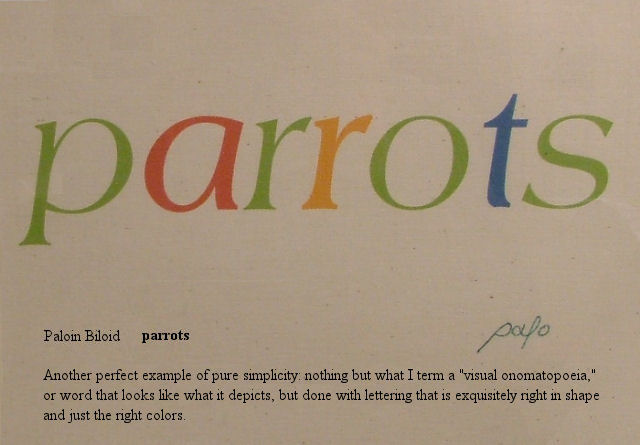Posts Tagged ‘the pre-awareness’
Entry 4 — The Nature of Visual Poetry, Part 2
Thursday, November 5th, 2009
Note to anyone dedicatedly trying to understand my essay, you probably should reread yesterday’s segment, for I’ve revised it. Okay, now back to:
The Nature of Visual Poetry
As a visual poem, Biloid’s “Parrots” is eventually processed in two significantly different major awarenesses, the protoceptual and the reducticeptual. In the protoceptual awareness, the processing occurs in the Visioceptual Awareness, to which it directly proceeds. In the reducticeptual awareness, it first goes to the Linguiceptual Awareness, which is divided into five lesser sub-awarenesses, the Lexiceptual, Texticeptual, Dicticeptual, Vocaceptual, Rhythmiceptual and Metriceptual. The first is in charge of the written word, the second of the spoken word, the third of vocalization, the fourth of the rhythm of speech and the fifth of the meter of speech. Of these, the linguiceptual awareness passes “Parrots” on only to the first, the lexiceptual awareness, because “Parrots” is written, not spoken. Since the single word that comprises its text will be recognized as a word there, it will reach its final cerebral destination, the Verbiceptual Awareness.
The engagent of “Parrots” will thus experience it as both a visioceptual and a verbiceptual knowlecule, or unit of knowledge–at about the same time. Visually and verbally, the first because it is visual, the second because it is a poem and thus necessarily verbal. Clearly, it is substantially more than a conventional poem, which would be processed entirely by its engagent’s verboceptual awareness.
Okay, this essay, only about a thousand words in length so far, is already a mess. Yes, way too many terms. And I keep needing to revise it for clarity. Or, at least, to reduce its obscurity. I have trouble following it myself. My compositional purpose right now, though, is to get everything down. Later, I’ll simplify, if I can.
Entry 3 — The Nature of Visual Poetry, Part 1
Wednesday, November 4th, 2009

The image above is from the catalogue of a show I co-curated in Cleveland that Michael Rothenberg was kind enough to give space to in Big Bridge #12–with two special short gatherings of pieces from the show, with commentary by me. I have it here to provide relief from my verosophizing (note: “verosophy” is my word for serious truth-seeking–mainly in science, philosophy, and history). It’s also a filler, for I’ve had too tough a day (doctor visits, marketing, phoning people about bills) to do much of an entry.
It’s not a digression, though–I will come back to it, as a near-perfect example of a pure visual poem.
Now, briefly, to avoid Total Vocational Irresponsibility, back to:
the Nature of Visual Poetry
The pre-awareness is a sort of confederacy of primary pre-aware- nesses, one for each of the senses. Each primary pre-awareness is in turn a confederacy of specialized secondary pre-awarenesses such as the visiolinguistic pre-awareness in the visual pre-awareness and the audiolinguistic pre-awareness in the auditory pre-awareness. Each incoming perceptual cluster (or “pre-knowlecule,” or “knowlecule-in-progress,” by which I mean cluster of percepts, or “atoms of perception,” which have the potential to form full-scale pieces of knowledge such as the visual appearance of a robin, that I call “knowlecules”) enters one of the primary pre-awarenesses, from which it is sent to all the many secondary pre-awarenesses within that primary pre-awareness.
The secondary pre-awarenesses, in turn, screen the pre-knowlecules entering them, accepting for further processing those they are designed to, rejecting all others. The visiolinguistic pre-awareness thus accepts percepts that pass its tests for textuality, and reject all others; the audiolinguistic pre-awareness tests for speech; and so on. More on this tomorrow, I hope.